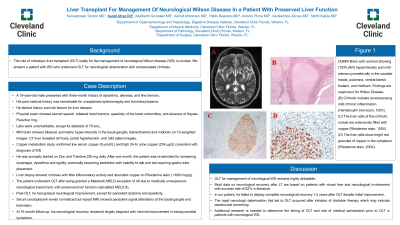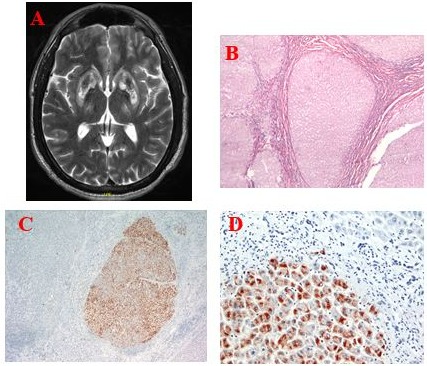Back


Poster Session C - Monday Afternoon
Category: Liver
C0597 - Liver Transplant for Management of Neurological Wilson Disease in a Patient With Preserved Liver Function
Monday, October 24, 2022
3:00 PM – 5:00 PM ET
Location: Crown Ballroom

Has Audio

Sadaf Afraz, DO
Cleveland Clinic Florida
Weston, Florida
Presenting Author(s)
Award: Presidential Poster Award
Kanwarpreet Tandon, MD1, Sadaf Afraz, DO1, Adalberto Gonzalez, MD1, Ashraf Almomani, MD2, Pablo Bejarano, MD1, Antonio Pinna, MD1, Xaralambos Zervos, MD1, Nikhil Kapila, MD1
1Cleveland Clinic Florida, Weston, FL; 2Cleveland Clinic Foundation, Cleveland, OH
Introduction: The role of orthotopic liver transplant (OLT) solely for the management of neurological Wilson disease (WD) is unclear. We present a patient with WD who underwent OLT for neurological deterioration with compensated cirrhosis.
Case Description/Methods: A 19-year-old male presented with three-month history of dysarthria, akinesia, and fine tremors. His past medical history was remarkable for unexplained splenomegaly and thrombocytopenia. He denied history and risk factors for liver disease. Physical exam showed slurred speech, bilateral hand tremors, spasticity of the lower extremities, and absence of Kayser-Fleischer ring. Labs were unremarkable, except for platelets of 79 k/uL. MRI brain showed bilateral, symmetric hyper-intensity in the basal ganglia, lateral thalami and midbrain on T2-weighted images. CT liver revealed cirrhosis, portal hypertension, and mild splenomegaly. Copper metabolism study confirmed low serum copper (8 µmol/L) and high 24-hr urine copper (234 µg/d) consistent with diagnosis of WD. He was promptly started on Zinc and Trientine 250 mg daily. After one month, the patient was re-admitted for worsening dysphagia, dysarthria and rigidity, eventually becoming bedridden with inability to talk and eat requiring G-tube placed). Liver biopsy showed cirrhosis with little inflammatory activity and abundant copper on Rhodanine stain ( >600 mcg/g). The patient underwent OLT after being granted a Metabolic MELD exception of 40 due to medically unresponsive neurological impairment, with preserved liver function (calculated MELD 8). Post-OLT, he had gradual neurological improvement, except persistent dystonia and spasticity. Serum ceruloplasmin levels normalized but repeat MRI showed persistent signal alterations at the basal ganglia and brainstem. At 16 month follow-up, his neurological recovery remained largely stagnant with minimal improvement in extrapyramidal symptoms.
Discussion: OLT for management of neurological WD remains highly debatable. Most data on neurological recovery after LT are based on patients with mixed liver and neurological involvement with success rate of 62%. In our patient, he failed to display complete neurological recovery 1.5 years after OLT despite initial improvement. The rapid neurologic deterioration that led to OLT occurred after initiation of chelation therapy which may indicate paradoxical worsening. Additional research is needed to determine the timing of OLT and role of medical optimization prior to OLT in patients with neurological WD.

Disclosures:
Kanwarpreet Tandon, MD1, Sadaf Afraz, DO1, Adalberto Gonzalez, MD1, Ashraf Almomani, MD2, Pablo Bejarano, MD1, Antonio Pinna, MD1, Xaralambos Zervos, MD1, Nikhil Kapila, MD1. C0597 - Liver Transplant for Management of Neurological Wilson Disease in a Patient With Preserved Liver Function, ACG 2022 Annual Scientific Meeting Abstracts. Charlotte, NC: American College of Gastroenterology.
Kanwarpreet Tandon, MD1, Sadaf Afraz, DO1, Adalberto Gonzalez, MD1, Ashraf Almomani, MD2, Pablo Bejarano, MD1, Antonio Pinna, MD1, Xaralambos Zervos, MD1, Nikhil Kapila, MD1
1Cleveland Clinic Florida, Weston, FL; 2Cleveland Clinic Foundation, Cleveland, OH
Introduction: The role of orthotopic liver transplant (OLT) solely for the management of neurological Wilson disease (WD) is unclear. We present a patient with WD who underwent OLT for neurological deterioration with compensated cirrhosis.
Case Description/Methods: A 19-year-old male presented with three-month history of dysarthria, akinesia, and fine tremors. His past medical history was remarkable for unexplained splenomegaly and thrombocytopenia. He denied history and risk factors for liver disease. Physical exam showed slurred speech, bilateral hand tremors, spasticity of the lower extremities, and absence of Kayser-Fleischer ring. Labs were unremarkable, except for platelets of 79 k/uL. MRI brain showed bilateral, symmetric hyper-intensity in the basal ganglia, lateral thalami and midbrain on T2-weighted images. CT liver revealed cirrhosis, portal hypertension, and mild splenomegaly. Copper metabolism study confirmed low serum copper (8 µmol/L) and high 24-hr urine copper (234 µg/d) consistent with diagnosis of WD. He was promptly started on Zinc and Trientine 250 mg daily. After one month, the patient was re-admitted for worsening dysphagia, dysarthria and rigidity, eventually becoming bedridden with inability to talk and eat requiring G-tube placed). Liver biopsy showed cirrhosis with little inflammatory activity and abundant copper on Rhodanine stain ( >600 mcg/g). The patient underwent OLT after being granted a Metabolic MELD exception of 40 due to medically unresponsive neurological impairment, with preserved liver function (calculated MELD 8). Post-OLT, he had gradual neurological improvement, except persistent dystonia and spasticity. Serum ceruloplasmin levels normalized but repeat MRI showed persistent signal alterations at the basal ganglia and brainstem. At 16 month follow-up, his neurological recovery remained largely stagnant with minimal improvement in extrapyramidal symptoms.
Discussion: OLT for management of neurological WD remains highly debatable. Most data on neurological recovery after LT are based on patients with mixed liver and neurological involvement with success rate of 62%. In our patient, he failed to display complete neurological recovery 1.5 years after OLT despite initial improvement. The rapid neurologic deterioration that led to OLT occurred after initiation of chelation therapy which may indicate paradoxical worsening. Additional research is needed to determine the timing of OLT and role of medical optimization prior to OLT in patients with neurological WD.

Figure: Image 1: (A) MRI Brain with contrast showing (T2/FLAIR) hyperintensity and mild edema symmetrically in the caudate heads, putamina, ventral lateral thalami, and midbrain. Findings are suspicious for Wilson Disease. (B) Cirrhotic nodules accompanying mild chronic inflammation (Hematoxylin and eosin, 100X). (C) The liver cells of this cirrhotic nodule are extensively filled with copper (Rhodanine stain, 100X) (D) The liver cells show bright red granules of copper in the cytoplasm (Rhodanine stain, 200X).
Disclosures:
Kanwarpreet Tandon indicated no relevant financial relationships.
Sadaf Afraz indicated no relevant financial relationships.
Adalberto Gonzalez indicated no relevant financial relationships.
Ashraf Almomani indicated no relevant financial relationships.
Pablo Bejarano indicated no relevant financial relationships.
Antonio Pinna indicated no relevant financial relationships.
Xaralambos Zervos indicated no relevant financial relationships.
Nikhil Kapila indicated no relevant financial relationships.
Kanwarpreet Tandon, MD1, Sadaf Afraz, DO1, Adalberto Gonzalez, MD1, Ashraf Almomani, MD2, Pablo Bejarano, MD1, Antonio Pinna, MD1, Xaralambos Zervos, MD1, Nikhil Kapila, MD1. C0597 - Liver Transplant for Management of Neurological Wilson Disease in a Patient With Preserved Liver Function, ACG 2022 Annual Scientific Meeting Abstracts. Charlotte, NC: American College of Gastroenterology.

